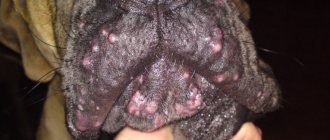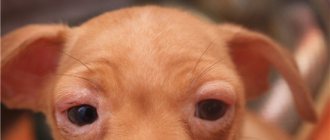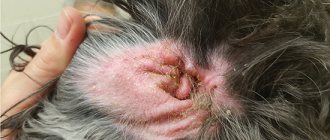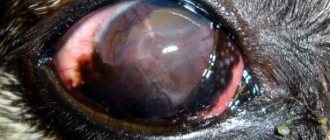Causes of the disease
Each of the listed types of disease has a reason for its appearance - the interaction of the animal with allergens.
Food
Most representatives of the pug breed are susceptible to the disease. There are 2 main reasons for the occurrence of pathology:
- Poor quality dry or liquid food. Cheap ready-made food saves owners money, but causes a lot of harm to the pet’s stomach. Such foods contain substances (mainly flavorings) that can serve as allergens. To avoid problems, it is better to refrain from purchasing budget foods such as Pedigree, Chappi, “Our Mark”, etc.
- The dog accidentally consumes foods that contain a large number of allergens.
It is difficult to identify a food variety, since it is not always possible to find out on the first try which product causes an undesirable reaction in the body. Therefore, the following should be excluded from the pet menu:
- flavorings, dyes, preservatives;
- cereals;
- eggs;
- dairy products;
- chicken;
- yellow fruits, vegetables;
- sweets (sweets, chocolate);
- corn;
- fish.
If you buy food, then only hypoallergenic food, for example, with rabbit, duck or turkey meat. These products cause fewer reactions, so they can be given as food.
Medicinal
This is a reaction to vaccinations, pills and other medications, such as:
- anti-inflammatory drugs;
- vaccines;
- sedatives;
- vitamin B
Drug allergies are insidious - its manifestations can not be noticed immediately, but after several doses of medication. Therefore, you need to carefully monitor your pet’s reaction to medications and the appearance of symptoms.
Chemical
Pugs are susceptible to allergens such as:
- shampoos, other household chemicals;
- vitamins;
- anti-flea collars.
Autoimmune
Although pugs rarely suffer from this allergy, it is the most life-threatening. The animal’s body perceives any cells, even its own, as unwanted and begins to fight them.
Contact
If you interact with allergens for a long time, such as toys, cheap plastic bowls, or synthetics, an allergic reaction may occur.
Classification of allergies - types
Subdivision by type is carried out according to the method of entry of the allergen substance into the animal’s body, by location and type of substance. All types of allergic reactions can occur in pug dogs.
Classification of allergies in dogs:
- Food.
- Contact.
- Atopic dermatitis.
- Insect.
- Respiratory.
- Bacterial (infectious).
- Medicinal.
- Autoimmune.
Allergens can enter a pug’s body in several ways:
- airborne (respiratory, atopic dermatitis, infectious);
- contact (contact);
- oral (food, medicinal, infectious);
- through bites (insect);
- injection (medicine).
If we talk about classification by location, we can distinguish otitis media of allergic origin into a separate type.
Food allergies
The second name for this type is food allergy. This type of allergy is most often detected in pug dogs. It is considered difficult to identify, because it is not always possible to identify the first time to which product the dog has an allergic reaction.
Most often, animals react to:
- food colors, artificial flavors and synthetic preservatives;
- cereals: soybeans, wheat, corn;
- egg;
- milk;
- yellow vegetables and fruits;
- canned food
- chicken.
Important: Hypoallergenic food formulas for pugs are developed based on veal, turkey, rabbit and duck meat. There is rarely an allergic reaction to these protein products.
Contact
Allergic reactions develop gradually after prolonged contact with objects that contain allergenic substances. Usually these are: pug care products, dog toys, plastic bowls for food and water; synthetic furniture upholstery, floor coverings, collars.
Atopic dermatitis
Genetic pathology of pugs, inherited from parents to offspring. The causative agent of the pathology is difficult and takes a long time to identify. A widespread disease in representatives of this breed, mainly due to haphazard selection carried out by unscrupulous breeders.
Most often, pugs have a reaction to:
- flower pollen;
- fluff of poplars and fireweed;
- poultry feather;
- dust mites;
- human dandruff;
- washing powder;
- mold spores.
The disease manifests itself differently in each specific case. But it is always accompanied by pathological lesions of the dog’s skin.
Insect
Another common type of allergy. The second commonly accepted name for the pathology is flea dermatitis. “Flea” is a conventional name. A dog can react to any insect that bites and stings. Allergens in this type are most often poison (wasps, bees, horseflies) and saliva of blood-sucking insects and parasitic insects (midges, mosquitoes, lice, lice, fleas, ixodid ticks).
Important: the best prevention of insect allergies is timely treatment for external parasites and wearing insecticidal collars while walking.
Respiratory
Allergies in a pug occur as a result of contact of the respiratory tract with aeroallergenic substances that are in the air. The dog inhales air with foreign substances - this causes specific reactions in it.
Common aeroallergens:
- household aerosols (air fresheners, hairspray, deodorants, furniture polishes, perfume);
- pollen;
- fungal and mold spores;
- wool and fluff of domestic animals.
This contact usually affects the pug's lungs and upper respiratory tract.
Bacterial (infectious)
Most often it occurs as a concomitant pathology.
Called:
- bacteria;
- viruses;
- fungi;
- endoparasites;
- pathogens of tuberculosis, brucellosis, leptospirosis;
- microorganisms.
Medicinal
The second name for pathology is medicinal. It manifests itself as a reaction of the animal’s immune system to medications and vaccines (vaccinations).
Allergen drugs:
- analgesics and anti-inflammatory drugs;
- drugs from the antibiotic group (tablets and injections);
- vaccines;
- sedatives, sedatives;
- sulfonamide;
- B vitamins;
- propolis-based medicines;
- preparations containing plant pollen.
Important: drug allergies have a cumulative effect. It may not appear the first time you use the drug.
Autoimmune
The most rarely diagnosed type of allergy and the most dangerous. With this form of allergy, the pug’s immune system mistakes its own cells for “enemies” that it begins to fight.
Manifestations of allergies in a pet
Some of the listed signs of pathology may not appear immediately, but over time or after repeated use of the product or drug. Therefore, discovering the cause of the disease is not easy.
Symptoms of the disease:
- Breathing problems. They are easy to notice if the animal wheezes, sneezes frequently, coughs or snores.
- Dandruff. When pugs have allergies, they can have a lot of them.
- Stomach problems such as vomiting.
- Unpleasant odor, redness, swelling, strange discharge from the ears.
- Large amounts of hair loss or bald spots.
- Itching. The animal becomes restless, it constantly licks itself, bites until it bleeds, and rubs against everything.
But such symptoms do not always indicate the presence of an allergy; they coincide with the signs of some other diseases. Therefore, initially you need to show the pug to a veterinarian, and not treat the pet yourself, otherwise the dog’s condition will only worsen.
How to recognize allergic otitis media
Any inflammation in the ear is called otitis media. Its causative agent can be bacteria, injury, infection, parasites, etc. When the root cause is one or another allergen, the disease is called allergic otitis.
The relationship is as follows: an irritant entering a dog’s body is recognized by the immune system as an infectious agent. Lymphocytes are sent to fight it. In order for antibodies to penetrate faster to the source of the allergen, histamine is released into the blood. It improves vascular permeability.
Lymphocytes form protective plaques and nodules, which looks like inflammation. In addition, the microflora is disrupted, itching and skin rashes appear. The pet begins to scratch the sore ear, introducing an infection into the blood.
Symptoms of ear allergies are similar to ordinary otitis media:
- swelling in the ear;
- redness, itching, dryness;
- elevated temperature;
- discharge from the ears;
- swelling of the muzzle;
- the pet shakes its head;
- the dog yelps when the ears are touched and does not allow this to be done;
- the animal walks with its head tilted to the side.
A food test can help you identify what is bothering your dog. To do this, step by step exclude one product from the animal’s menu. If the symptoms go away, it is a food allergy; if the symptoms remain, it is otitis media.
How are allergies diagnosed?
It is not always easy to identify allergens. Specialists use equipment and tests. But even given the fact that a lot of money is spent on research, the source of the disease is often not found. Therefore, it is not worth treating a pug without consulting a doctor and undergoing examinations.
To diagnose allergies, information about symptoms is collected. At this stage, there is no need to hide anything from the doctor. Tell us what your pet ate, where it went for walks, and what it interacted with.
In addition, additional procedures are carried out:
- tests for the presence of parasites;
- collection of urine, feces and blood;
- allergy tests;
- wool inspection;
- skin scrapings.
Before identifying the type of allergic reaction, the doctor checks to see if it is a disease with similar symptoms. After the veterinarian is sure that the pug still has an allergy, they do tests for reactions and determine the source by elimination. The most common causes (diet and parasites) are checked first.
Treatment
After the veterinarian has checked everything, performed the necessary tests and received enough results, a diagnosis is made. Despite the fact that treatment is individual and depends on different parameters of the animal, therapy comes down to changing the pet’s lifestyle or diet.
What is done for preventive treatment:
- The optimal nutrition for the dog is established and the food is changed.
- Work is being done to eliminate all symptoms.
- The possibility of your pet interacting with allergenic substances is eliminated.
It is not recommended to treat allergies yourself, without consulting a doctor - this can worsen the situation.
Prevention
The main preventative measure is to prevent your pet from coming into contact with the allergen. After therapy, the dog needs a hypoallergenic diet for another 2-3 months, which should not be neglected. New ingredients must be introduced into the diet very carefully, preferably in consultation with a veterinarian. Make sure your pet does not pick up food on the street.
Increased attention should be paid when treating with medications (especially antibiotics), adding new plants to the house, or changing shampoo or laundry detergent. Try to use household chemicals less often, and when washing your pug’s fur, it is better to use natural soap. If the allergy was caused by an insect bite, do not walk your dog where he can “catch” a tick. For prevention, you also need to follow a treatment schedule for worms and parasites.
If you like to walk your dog in overalls or other clothing, put higher demands on its quality. Inexpensive items are usually made from materials saturated with toxic dyes. This can be a major irritant for your Pug.
Pay more attention to your pet, be vigilant and monitor the dog’s health so that he is happy and satisfied with life.
Medicines for internal use
You should not use the listed remedies without consulting a doctor who examined the dog, made a diagnosis and prescribed treatment. Dosages may vary depending on the characteristics (height, weight) of the pug.
Doctors prescribe:
- Apoquel or Cyclosporine. They act as painkillers and are used against inflammation.
- Ear drops, tablets: Sofradex, Surolan. These are antibiotics that help avoid secondary infections.
- Antihistamines that improve general condition. For example, Suprastin, Diazolin.
- Cycloferon. The drug is prescribed as an immunostimulant to make recovery much faster.
- Vitamins C, E and omega-3 acids (prescribed to give your pet strength).
Nutrition correction
To treat a food allergy, you first find the food that causes it. A mono-diet helps identify the allergen.
Basic rules for preparing a diet:
- From protein sources, choose one that the dog has not previously eaten. For example, you can give your pet lamb or rabbit meat.
- During the diet, use only hypoallergenic cereals. For a month, the dog should eat exclusively rice porridge with meat.
- Over the next 2-4 weeks, gradually add new foods. Once any of these begin to cause allergy symptoms in your dog, such as redness, they should be completely eliminated from the diet. Then continue to add new food again to determine the presence or absence of a reaction.
At the end of the diet, only those foods will remain to which the pet has no negative reactions. They can be used without worrying about your pet's health. When feeding dry or liquid food, it is recommended to select products from a good manufacturer, experimenting and observing the animal.
The best solution is to buy hypoallergenic food. Such food should be free of grains (except rice), flavorings, and preservatives.
When do you need veterinary help?
You should always contact a veterinarian. Even if your dog exhibits some symptoms (redness, itching), it is better to visit a doctor rather than treat the allergy yourself. Often, diagnoses can only be made based on the results of studies (using special equipment) and tests. If you ignore the symptoms, complications may occur.
There are symptoms when you should not hesitate:
- increased body temperature;
- profuse frequent vomiting;
- diarrhea;
- pain when palpating the auricle, leakage of exudative fluid.
In addition, animals often have reactions to medications, vaccinations, vitamins, and flea collars. If you notice that your dog is depressed, his appetite has worsened, or his hearing acuity has decreased, call a doctor or take your pet to a veterinary clinic. Only a specialist can help, since without a confirmed diagnosis it is not recommended to give medications on your own.
Video: HOW TO PERSUADE YOUR PARENTS TO BUY A DOG
- boiled and raw poultry; egg yolk; sweets (chocolate, candies, etc.) as well as flour products; treats for animals (various kinds of “bones”, dragees and other products that contain dyes and artificial additives); dairy products; yeast; oatmeal, semolina and wheat soybean cereals and products made from it; Fish and seafood
An environmental allergy is one that is related to the pet's environment. This type of allergy can also be divided into two subtypes, in particular:
Seasonal allergies are the same type of allergies that people are susceptible to and are associated with a specific time of year. The cause of this allergy is pollen from various plants (trees, grasses, spores of certain types of fungi, etc.)
Year-round. This subgroup includes house dust, mold and, of course, fleas and ticks.
Chemical – occurs when a pet’s body reacts to substances contained in medications, as well as dog care items. It can be:
- flea collar; shampoos, sprays, etc.; various vitamin supplements; any type of medicine.











